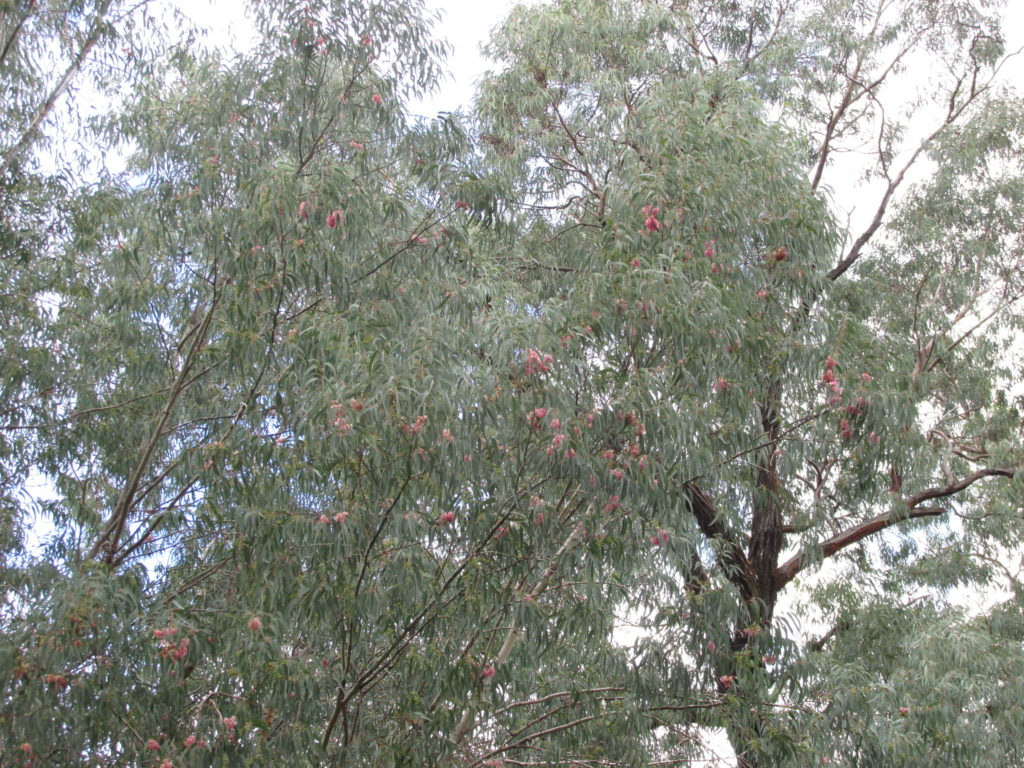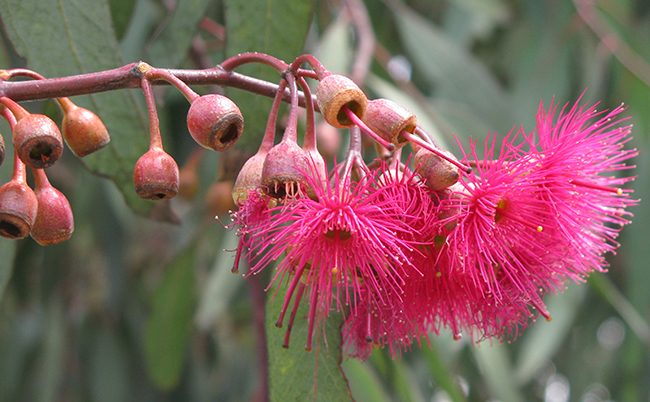- About Us
- Our Work
- Tree Info
- Get Involved
- Blog
- Support Us
By Canopy Team on May 6, 2019

Photo by Forest & Kim Starr via Flickr
Tree Spotlight Series: Follow along as we learn about the fascinating trees that live among us. This series is in partnership with Rhee Lab in the Plant Biology Department of the Carnegie Institution for Science.
Other posts in the series: ginkgo biloba, Douglas fir, giant sequoia, Chinese tallow, silver-dollar gum, Monterey pine, green dracaena, coast live oak, cork oak, Japanese maple, silver birch, dawn redwood, Japanese persimmon ‘Hachiya’, carob, California bay, avocado, southern magnolia, and flowering dogwood.
The history of eucalyptus trees in California stretches as far back as the mid 1850s, when the genus was first imported from Australia and quickly became established as a promising source of fiber and timber. After being extensively planted, eucalyptus trees became integral to California’s forestry and lumber industry.
Of these species, the red ironbark eucalyptus, or the Eucalyptus sideroxylon, stands out as one that is particularly stalwart in the face of stressful conditions.
This tree is a moderate to long lived evergreen species that can grow up to 82 feet tall, about 7.5 stories. As the tree grows slowly, the previous year’s bark is cemented with kino, a type of gum that eucalyptus trees release as a reaction to physical damage, resulting in a dark grey, weathered outer layer of bark on the main trunk.
Underneath this tough coating of bark, the red wood of the tree is strong and hard, hence the name of red ironbark. While physically tough, the bark also possesses chemicals called polyphenols that include stilbenes and ellagitannins that inhibit fungal growth, thereby protecting the wood against decay.
Along with the bark, the leaves contain an oil that can serve as natural disinfectants, but is toxic in large quantities, guarding the tree against insect pests. Furthermore, this tree is drought and frost tolerant, allowing it to survive beyond its native habitats.
Although the tree can produce stems that have single flowers, most flowering stems have an odd number—3, 5, 7, 9, or 11—of flowers that can be colored cream, pink, or a deep rose red, resulting in different aesthetic variations that are used for ornamental purposes.

The fact that the red ironbark eucalyptus is a hardy species contributes to its popular use as timber. Most eucalyptus plantations devote space to red ironbark eucalyptus trees, as this species can survive in climates that most other eucalyptus trees cannot, resulting in a dependable source of timber. Once processed into timber, the dense, durable wood has been used in a wide variety of heavy duty applications including building bridges, beams, buildings, railway sleepers, and other heavy construction structures.
Furthermore, this species is crucial for producing honey in its native habitat of New South Wales in Australia. In terms of supporting ecosystems, while the tree’s leaves are toxic, many herbivores, including koalas, are tolerant of it and depend on the leaves as a food source. Additionally, the flowers produce a lot of nectar, providing food for many pollinators ranging from insects to birds and even possums.
In the realm of medicine, the tree’s oil possesses a wide range of activities including anti-microbial, fungicidal, insecticidal, and herbicidal qualities, popularizing the oil’s use to treat many maladies. Finally, the tree has ornamental value stemming from its brightly colored flowers, as well as from the tall, dominant appearance of the tree. A point of pride of many communities, this tree serves as a bridge between the natural and the urban world, originating from the former while still being able to survive in and improve the latter.
See the red ironbark in person! With its dark red-brown bark and deep furrows, one can easily distinguish it from other eucalyptus species. On Canopy’s West Bayshore Tree Walk you’ll find this distinctive tree located near Ohlone Elementary School in Palo Alto.

Ankush Bharadwaj was a 2018 summer intern at the Rhee Lab in the Plant Biology Department of the Carnegie Institution for Science. He is currently an undergraduate student majoring in Microbiology, Immunology, and Molecular Genetics at the University of California, Los Angeles. His hobbies include being outdoors, where he usually spends his time kayaking, hiking, or simply skateboarding around.